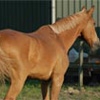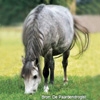|
Advice article filter
|
WeightThere are several ways to see or feel if your horse is too heavy or too thin. Look at your horse from behind, or feel his ribs. Your horse has the perfect weight when you cannot see his ribs, but you can feel them easily with the flat of your hand. His neck is nice and supple and the spine is the highest point of the back. For an optimal health it is important that your horse is not too thin, but certainly not too heavy either. To determine the weight of your horse you can use a scale (for instance at your veterinary clinic) or a special tape. It is also important to keep score of his condition, because numbers and kilos alone can’t tell you the whole story. My horse is too heavy, what can I do Reduce the amount of his concentrates, or feed a product that provides less energy. Is your horse out on a rich pasture, reduce his pasture time and increase his exercise schedule. Make sure your mare doesn’t loose too much weight when she is pregnant. My horse is too thin, what can I do After you’ve been able to verify that your horse has no physical problems, we advise increasing his daily ration. Give your horse more hay, or even continuous access to hay and/or provide (extra) pasture time. You can also increase the amount of concentrates or change to a product that provides more energy. Is your horse merely too thin in his flanks or his belly, but you can’t see his ribs? In that case your horse isn’t too thin, but he has a shortage of roughage. Give your horse more hay and/or (extra) pasture time  
|

